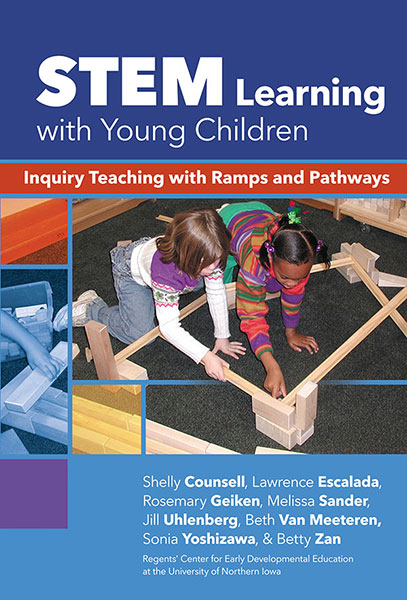Professors: Request an Exam Copy
Print copies available for US orders only. For orders outside the US, see our international distributors.
Shelly L. Counsell, Lawrence Escalada, Rosemary Geiken, Melissa Sander, Jill Uhlenberg, Beth Dykstra Van Meeteren, Sonia Yoshizawa, Betty Zan
Publication Date: December 28, 2015
Pages: 216
Series: Early Childhood Education Series

This teacher’s guide provides the background information, STEM concepts, and strategies needed to successfully implement an early STEM curriculum (Ramps and Pathways) with young children, ages 3–8. R&P actively engages young children in designing and building ramp structures using wooden cove molding, releasing marbles on the structures, and observing what happens. Children use logical-mathematical thinking and problem-solving skills as they explore science concepts related to motion, force, and energy. This guide helps teachers to:
This one-of-a-kind resource uses a newly created Inquiry Teaching Model (ITM) as the conceptual framework and devotes specific attention to the importance of an inclusive and social, STEM learning environment in which children are free to collaborate, take risks, and investigate within the context of exploratory and constructive play.
Shelly L. Counsell is assistant professor of early childhood education at the University of Memphis. Lawrence Escalada is professor of physics and science education and head of science education at the University of Northern Iowa. Rosemary Geiken is an associate professor in the early childhood program at East Tennessee State University. Melissa Sander is a special education teacher in the Wapsie Valley Community School District, Iowa. Jill Uhlenberg is associate professor and head of Curriculum and Instruction at the University of Northern Iowa. Beth Van Meeteren is director of the Regents’ Center for Early Developmental Education and Center for Early Education in STEM at the University of Northern Iowa. Sonia Yoshizawa is a doctoral fellow in the early childhood education program at East Tennessee State University. Betty Zan is associate professor of early childhood education at the University of Northern Iowa.
"The authors summarize the importance of STEM-based education, provide a practical approach, and place it in the context of classrooms from the preschool to second-grade level. Early childhood educators who are interested in moving away from a siloed approach to teaching content, looking to integrate across content areas, and making STEM education an important part of their classrooms should read this book. Using R&P could be an excellent entry point or foundation for educators seeking to better integrate content and infuse STEM learning into their classrooms."
—Teachers College Record
"Written by eight remarkable educators, this powerful book carefully illustrates the design and teacher practices of constructivist classrooms that nurture the whole child. The authors describe how teachers can scaffold young children’s building of global competencies through inventive, imaginative, and intentional problem solving. The teaching/assessment dynamic unfolds with new resources throughout the text."
—Jacqueline Grennon Brooks, professor, curriculum & teaching, director of the IDEAS Institute, Hofstra University
"This book is a must for all concerned with the education of young children. Using ramps and pathways as an exciting and stimulating example of how to engage children in rich STEM experiences, this team of highly knowledgeable and skilled researchers and practitioners draw from their deep and extensive backgrounds to present a clear and comprehensive view of the current landscape of inquiry-based STEM teaching and learning for young children. It is a book that can and should inform both policy and practice."
—Karen Worth, Elementary Education Department, Wheelock College
Professors: Request an Exam Copy
Print copies available for US orders only. For orders outside the US, see our international distributors.